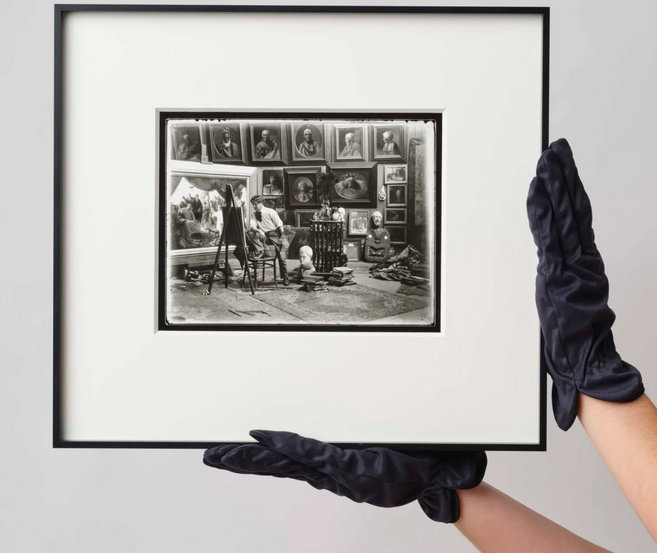New Zealand auction house, Webb’s, has encouraged buyers of two historic glass plate negatives – that were also included in auction as digital assets, NFTs – to ‘smash’ the original plates to ‘make it permanently digital’.

The glass plate negatives are portraits of renowned New Zealand artist, Charles Goldie, likely captured by Rupert Farnall Studios sometime between 1910 and 1920. Webb’s describes both negatives as having ‘survived’ and ‘in excellent condition to this day’. The auction of the two lots feature the NFT, the original glass plate negative in a custom-built pine box, a framed contact print of the image, and a ‘small brass hammer’ should the buyer wish to smash the glass plates.
‘We are taking something made on a specific day and specific time and is really important to New Zealand’s history and in a way we are making it immortal,’ said head of art at Webb’s auction house, Charles Ninow, to Newshub NZ.
Webb’s is also encouraging the destruction of that ‘important’ historical document, with Ninow later quoted in the article saying: ‘Perhaps you might want to make it permanently digital. Smash it? Smash it.’
WTF is an NFT: A refresher
An NFT is a non-fungible token – a one-of-a-kind digital asset that are bought and sold with cryptocurrencies and stored on a blockchain, a secure online data ledger. The NFT craze came into mainstream consciousness last year after Michael Joseph Winkelmann, AKA Beeple, sold a piece of digital graphic art in March 2020 for US$69.3 million.
Big sellers in the NFT space include memes and tacky graphic art, and there really is no limitations or rhyme or reason to what might sell. The Associated Press jumped aboard the NFT gravy train by selling a re-imagined short video drawing from Joe Rosenthal’s iconic image, Raising the flag on Iwo Jima.
Extraordinary sums of money some NFTs have sold for is mind boggling, made all the more bizarre by the fact that it’s entirely digital and no physical copy exists. An NFT aficionado may respond by pointing out how all art is truly only ‘worth’ the materials used to create it, and the additional value we ascribe is imaginary – so what’s the big difference?
Some serious art collectors have begun including NFTs in their collections. the whole digital art marketplace starts looking more serious. Although since the art world came to grips with NFTs – what it means and how to deal with it – fortunes have been made and lost, and more lately the NFT marketplace has made headlines for being rife with fraudulent activity and potential copyright infringement.
A lengthy analysis of landscape photographers selling NFTs by UK photographer, Daren Cox, for DIY Photography, found that over four days on one NFT marketplace 50 photographers generated approximately US$780K. This figure is based on what Ethereum was trading against the US dollar at the time., with 390 Ether trading hands.
The most sales were generated by US photographer, Ben Strauss, who flipped around US$51K of work in just four days; while the lowest was another US photographer, Richard Bernabe, who made around US$4740. There were a couple of Australians in the mix. Steve K, who at number 25 on the list made around US$12K in four days, as well as Robert Downie, number 35 who made US$8K of sales.
When considering how difficult it is to make a living selling landscape artwork/prints, these photographers have nicely targetted a new revenue stream. Although it ain’t necessarily easy to hustle in the NFT game, and sometimes it’s more about performing stunts to generate hype.
Smashing historical records
Webb’s essentially cashed in on the NFT hype. Minting an NFT of the Charles Goldie portraits, and providing a hammer to the buyers of the original glass plate negatives, boils down to creating a viral publicity stunt.
Like how absurd! We’re now not only buying digital copies artworks, but encouraging the destruction of the original version to make the digital version rarer. Has the world gone mad!?
This little stunt paid off big time for Webb’s. The two lots were auctioned from January 28 to February 1, with the estimated valuation both sitting between NZ$5000-$8000. The second lot, a beautiful shot of Goldie in his studio surrounded by Maori portraits and other paraphernalia, sold for NZ$76,250, while the other portrait sold for NZ$51,250.
It’s likely the glass plate negative and print alone wouldn’t pull upwards of NZ$50K each. Perhaps this new entrepreneurial approach of including an NFT with existing prints could be the way forward for photography to start selling for more on the secondary art market.





NFT’s have nothing to do with art. They are simply another money making scheme!
Webb’s are morally bankrupt.
Smash Webb’s